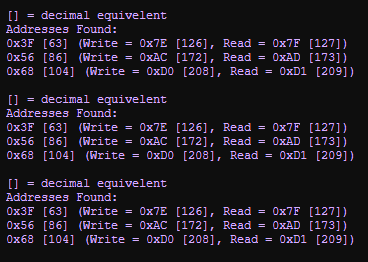Difference between revisions of "Component: LCD I2C (Backpack) ()"
| Line 51: | Line 51: | ||
the sniffer will send data to your PC via UART to USB. | the sniffer will send data to your PC via UART to USB. | ||
| − | The Arduino range and clones will have it built-in | + | The Arduino range and clones will have it built-in. |
| + | |||
| + | More details on I2C can be found here, | ||
| + | |||
| + | [http://www.matrixtsl.com/blog/simplified-communications-i%c2%b2c-and-spi/ Matrix Flowcode Blog: Simplified communications I2C and SPI] | ||
==Downloadable macro reference== | ==Downloadable macro reference== | ||
Revision as of 09:26, 1 March 2022
| Author | Matrix Ltd |
| Version | 2.2 |
| Category |
Contents
LCD I2C (Backpack) component
Standard alphanumeric LCD based on a standard I2C control bus. Usually using either a PIC device or Microchip IO expander IC.
Component Pack
DISPLAYS
Detailed description
No detailed description exists yet for this component
Examples
A simple example that shows how to use some common functions.
If the display is not showing the expected characters, the I2c address or contrast could be wrong.
The correct I2C address can be determined by using an ![]() IC2 Address Sniffer
IC2 Address Sniffer
The I2C address to use is the one within square brackets on the far right.
For example, with my backpack display, the correct address to use is 39:
the sniffer will send data to your PC via UART to USB.
The Arduino range and clones will have it built-in.
More details on I2C can be found here,
Matrix Flowcode Blog: Simplified communications I2C and SPI
Downloadable macro reference
| Clear | |
| Return | |
| PrintString | |
| Text | |
| Return | |
| PrintAscii | |
| Takes the ascii value for a character and prints the character | |
| character | |
| Return | |
| PrintNumber | |
| Allows you to print a number. This is limited to a signed-INT, -32768 to 32767 | |
| Number | |
| Return | |
| BacklightControl | |
| State | |
| Return | |
| ClearLine | |
| Line | |
| Return | |
| Cursor | |
| Moves the cursor on the LCD Display | |
| x | |
| y | |
| Return | |
| ScrollDisplay | |
| Scrolls the display left or right by a number of given positions. | |
| position | |
| direction | |
| Return | |
| Start | |
| Startup routine required by the hardware device. | |
| Return | |
